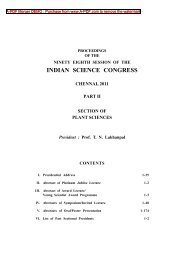sustainable use of biological diversity.pdf - India Environment Portal
sustainable use of biological diversity.pdf - India Environment Portal
sustainable use of biological diversity.pdf - India Environment Portal
You also want an ePaper? Increase the reach of your titles
YUMPU automatically turns print PDFs into web optimized ePapers that Google loves.
Introduction<br />
Introduction<br />
The urge for survival has led humans to explore<br />
their surrounding natural environment for usable<br />
resources and cultivation. This in turn has led humans<br />
to master the various <strong>use</strong>s <strong>of</strong> available natural<br />
resources, as well as to find the best ways <strong>of</strong><br />
extracting them. On the other hand, humans have<br />
also learned about the negative impacts their activities<br />
can have on the natural environment, including<br />
natural resource depletion, decreased production<br />
and soil erosion, and that a balanced way <strong>of</strong> utilizing<br />
and managing land and natural resources is vital to<br />
ensure that the land continuously provides necessary<br />
natural resources. Over time, humans have gradually<br />
developed unique systems based on harmonious<br />
interactions with their natural environment. These<br />
<strong>sustainable</strong> systems have enhanced land management<br />
practices and made natural resource <strong>use</strong> more<br />
effective. These socio-cultural systems and associated<br />
traditional ecological knowledge are forces that<br />
have, over centuries, shaped and formed unique<br />
landscapes adapted to various geographical and<br />
socio-cultural backgrounds around the world. Such<br />
<strong>sustainable</strong> human-influenced landscapes, which<br />
have been known to be beneficial for bio<strong>diversity</strong><br />
conservation and human well-being, are referred to<br />
here as socio-ecological production landscapes.<br />
To conserve bio<strong>diversity</strong>, considerable efforts have<br />
been foc<strong>use</strong>d on preserving pristine environments,<br />
such as wilderness, where human activities are<br />
minimal. However, bio<strong>diversity</strong> conservation also<br />
involves human-influenced areas, such as socio-ecological<br />
production landscapes, which can contain<br />
rich <strong>sustainable</strong> practices and traditional knowledge.<br />
These landscapes are found throughout the world<br />
under various local names, such as dehesa in Spain,<br />
muyong in the Philippines and chitemene in Malawi.<br />
In Japan, such landscapes are termed satoyama, a<br />
combination <strong>of</strong> two words which denote mountains,<br />
woodlands and grasslands (yama) and surrounding<br />
villages (sato).<br />
However, these landscapes are increasingly threatened<br />
in many parts <strong>of</strong> the world due to various pressures<br />
such as unplanned urbanization, industrialization<br />
and diminishing rural population. To tackle<br />
the critical issue, the Ministry <strong>of</strong> the <strong>Environment</strong><br />
<strong>of</strong> Japan (MOE-J) and the United Nations University<br />
Institute <strong>of</strong> Advanced Studies (UNU-IAS) jointly<br />
initiated the Satoyama Initiative to promote activities<br />
based on fundamental principles and guidelines<br />
(such as the Ecosystem Approach) towards the long<br />
term goal <strong>of</strong> “realizing societies in harmony with nature.”<br />
This Initiative covers a wide range <strong>of</strong> humaninfluenced<br />
areas, such as villages, farmlands, and adjacent<br />
woodlands and grasslands, which have been<br />
formed and maintained sustainably and which have<br />
the potential to contribute to both bio<strong>diversity</strong> conservation<br />
and human well-being.<br />
This document is a collection <strong>of</strong> case studies and<br />
articles that address how relationships between humans<br />
and nature function in socio-ecological production<br />
landscapes around the world. The examples<br />
highlight the various physical structures, management<br />
techniques and governance systems that characterize<br />
these landscapes, as well as the benefits they<br />
provide for bio<strong>diversity</strong> and human well-being, the<br />
threats they currently face, and ways to address these<br />
threats. Case studies were submitted to the Secretariat<br />
<strong>of</strong> Convention <strong>of</strong> Biological Diversity (SCBD)<br />
and field studies were conducted for the UNU-IAS.<br />
Case studies were submitted to the SCBD by experts<br />
as voluntary contributions to a call made by SCBD<br />
in collaboration with MOE-J and UNU-IAS, as part<br />
<strong>of</strong> the in-depth review on the <strong>sustainable</strong> <strong>use</strong> <strong>of</strong> bio<strong>diversity</strong><br />
in preparation for the fourteenth meeting<br />
<strong>of</strong> the CBD Subsidiary Body on Scientific, Technical<br />
and Technological Advice (SBSTTA-14) and the<br />
tenth Meeting <strong>of</strong> the Conference <strong>of</strong> the Parties to the<br />
CBD (COP-10).<br />
The first part <strong>of</strong> this document presents a selection<br />
<strong>of</strong> synthesis articles <strong>of</strong> relevance to socio-ecological<br />
production landscapes worldwide. An approach to<br />
addressing bio<strong>diversity</strong> conservation through the<br />
inclusion <strong>of</strong> human communities, and indicators to<br />
measure socio-ecological resilience, are presented.<br />
Based on four case studies from Suriname, Cameroon,<br />
Guyana, and Thailand, the characteristics <strong>of</strong><br />
customary <strong>sustainable</strong> <strong>use</strong> <strong>of</strong> bio<strong>diversity</strong> by indigenous<br />
peoples, and the threats customary management<br />
systems are currently facing, are highlighted.<br />
Protected landscapes across North America, and the<br />
diverse governance regimes associated with these<br />
landscapes, are then explored. Finally, the opportunities<br />
and challenges in surveying the coverage and<br />
remains <strong>of</strong> cultural landscapes in Europe are presented.<br />
The second part <strong>of</strong> the document presents 23 case<br />
studies <strong>of</strong> socio-ecological production landscapes<br />
around the world. These case studies cover 18 countries:<br />
Argentina, Australia, Bangladesh, Cambodia,<br />
Germany, <strong>India</strong>, Ireland, Italy, Japan, Kenya, Mexico,<br />
Peru, Portugal, Spain, Sri Lanka, Solomon Islands,<br />
Tanzania, and United States <strong>of</strong> America (figure 1).<br />
The case studies are representative <strong>of</strong> various climates,<br />
including tropical, sub-tropical, Mediterranean,<br />
and temperate climates, and geomorphic<br />
environments, including plains, hills, coasts and<br />
mountainous areas, or a mixture <strong>of</strong> these. In addi-<br />
5
















